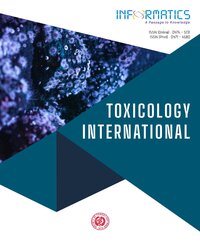Acute Toxicity Study of Anti-Diarrheal Herbal Combination in Mice
Subscribe/Renew Journal
This study was conducted to test the acute anti-diarrheal toxicity made from a combination of herbal extracts contain leaves of guava (Psidium guajava), turmeric (Curcuma domestica), fruit mojokeling (Terminalia chebula) and pomegranate (Punica gratum) peel. In vivo study was carried out on female Swiss Webster mice at the Toxicology Pharmacology Laboratory of the Institut Teknologi Bandung Pharmacy School. The five tested dose levels were the equivalent dose of 1/2 (164 mg/kg mice body weight) and one (328 mg/kg mice body weight) humans daily dose and three other doses, at 1, 2, and 5 g/kg body weight in mice and one control group. The assessment included observing animal behavior caused by toxic effect after test sample administration, if any, compared to its behavior before giving the test preparation (T0) and to the control. Observations were made carefully during the first 4 hours after test preparation administration and at T8, T24, and continued periodically every day until the endpoint of testing (H14). Changes in body weight were also monitored daily and at the endpoint, the animals were sacrificed for macroscopic examination of organs and organ index determination. The results showed no behavioral and clinical signs of toxicity were found after administering anti-diarrheal herbal combination at all testing doses. There were no animals that died during the treatment, and the macroscopic examination shows there were no abnormalities found in vital organs (lungs, heart, liver, kidney, stomach) after administration of anti-diarrheal products up to a dose of 5 g/kg body weight of mice. Taking all these into account, it can be concluded that those as mentioned earlier, the anti-diarrheal herbal combination is not toxic, and its lethal dose of 50 (LD50) is >5 g/kg mice body weight.
Keywords
Acute Oral Toxicity, Herbal Combination Anti-Diarrheal, LD50.
User
Subscription
Login to verify subscription
Font Size
Information
- Kementrian Kesehatan Republik Indonesia. Riset Kesehatan Dasar. 2018. [Last accessed on 2021 Apr 12]. https://kesmas.kemkes.go.id/assets/upload/dir_519d41d8cd98f00/files/Hasil-riskesdas-2018_1274.pdf
- Gregorio GV, Gonzales ML, Dans LF, Martinez EG. Polymer-based oral rehydration solution for treating acute watery diarrhea. Cochrane Database Syst Rev. 2016; 12(12):CD006519. https://doi.org/10.1002/14651858.CD006519.pub3
- De Hostos EL, Choy RK, Nguyen T. Developing novel antisecretory drugs to treat infectious diarrhea. Future Med Chem. 2011 Aug; 3(10):1317–25. https://doi.org/10.4155/fmc.11.87
- Harvey RA, Champe CC. Lippincottt’s illustrated reviews: Pharmacology 4th Ed. Philadelphia: Lippincott Williams and Wilkins: 2009
- Ibhanesebhor O. Review of the role of loperamide and codeine in the management of symptomatic diarrhoea in adults. [Last accessed on 2021 Apr 12]. http://www.who.int/selection_medicines/committees/expert/18/applications/LoperamideCodeine.pdf
- Muaro. Herbal dan Obat Tradisional. 2009. [Last accessed on 2021 Apr 12]. www.muaro.com/obattradisional
- Gakunga JN, Mirianga B, Muwonge H, Sembajwe LF, Kateregga J. Antidiarrheal activity of ethanolic fruit extract of Psidium guajava (Guava) in castor oil induced diarrhea in albino rats. National Journal of Physiology, Pharmacy and Pharmacology. 2013; 3(2):191–7. https://doi.org/10.5455/njppp.2013.3.100620131
- Ojewole JAO, Awe, EO, Chiwororo WDH. Antidiarrhoeal activity of Psidium guajava Linn. (Myrtaceae) leaf aqueous extract in rodents. J Smooth Muscle Res. 2008; 44(6):195–207. https://doi.org/10.1540/jsmr.44.195
- Palombo EA. Phytochemicals from traditional medicinal plants used in the treatment of diarrhoea: Modes of action and effects on intestinal function. Phytother Res. 2006; 20(9):717–24. https://doi.org/10.1002/ptr.1907
- Mukinda JT, Eagles, PF. Acute and sub-chronic oral toxicity profiles of the aqueous extract of Polygala fruticosa in female mice and rats. J Ethnopharmacol. 2010; 128(1):236–40. https//:doi/10.1016/j.jep.2010.01.022
- Badan Pengawasan Obat dan Makanan RI (BPOM RI). Pedoman Uji Toksisitas NonKlinik secara in vivo, PerkBPOM no7/2014.
- Organization for Economic Co-operation and Development (OECD). Guideline for the testing of chemicals 423. Documentation on acute oral toxicity and acute class method. 2012. [Last accessed on 2021 Apr 12]. http://www.oecd.org
- Laurence DR, Bacharah AL. Evaluation of drug activities: Pharmacometric, London: Academic Press Inc. Ltd; 1964.
- Sahgal G, Ramanathan S, Sasidhara S, Mordi M, Ismail S, Manso, SM. Brine shrimp lethality and acute oral toxicity studies on Swietenia mahagoni (Linn.) Jacq. Seed methanolic extract. Phcog Res. 2010; 2:215–20. http://doi.org/10.4103/0974-8490.69107
- Jaiarj P, Khoohaswan P, Wongkrajang Y, Peungvicha P, Suriyawong P, Saraya ML, Ruangsomboon O. Anticough and antimicrobial activities of Psidium guajava Linn. leaf extract. J Ethnopharmacol. 1999 Nov 1; 67(2):203–12. https://doi.org/10.1016/S0378-8741(99)00022-7
- Bassiri Jahromi S, Pourshafie MR, Mirabzadeh E, Tavasoli A, Katiraee F, et al. Punica granatum Peel Extract Toxicity in Mice, Jundishapur J Nat Pharm Prod. 2015; 10(4):e23770. http://doi.org/10.1775/jjnpp-23770
- Kamsu Tchuente G, Fodouop Chegaing SP, Tagne RS, Kodjio N, Fakam Nguelebeck AL, Gatsing D. Evaluation of the acute and sub-chronic toxicity of the ethanolic extract of Curcuma longa (Zingiberaceae) in Wistar albino rats. Mod Chem Appl. 2019; 7:267. https://doi.org/10.35248/2329-6798.19.7.267
- Jafari M, Naeini KM, Lorigooini Z, Namjoo R. Oral acute and sub-acute toxic effects of hydroalcoholic Terminalia chebula Retz and Achillea wilhelmsii extracts in BALB/c mice. Biomedicine (Taipei). 2019; 9(4):25. https://doi.org/10.1051/bmdcn/2019090425
- Vahalia MK, Thakur KS, Nadkarni S, Sangle VD. Chronic toxicity study for Tamra Bhasma (A generic Ayurvedic mineral formulation) in laboratory animals. Res Sci Technol. 2011; 3:76–9. http://doi/10.4103/0250-474X.117433
- Rajeh MA, Kwan YP; Zakaria Z, Latha LY, Johty SL, Sasidharan S Acute toxicity impacts of Euphorbia hirta L extract on behavior, organs body weight index and histopathology of organs of the mice and Artemia salina. Pharmacognosy Res. 2012 Jul; 4(3):170–7. https://doi.org/10.4103/0974-8490.99085
- Chan PK, Hayes AW. Acute toxicity and eye iritancy. 1994. A.W, Hayes, Ed. Principles and Methods of Toxicology Third Edition. New York. ven Press: 1994.

Abstract Views: 431

PDF Views: 0



